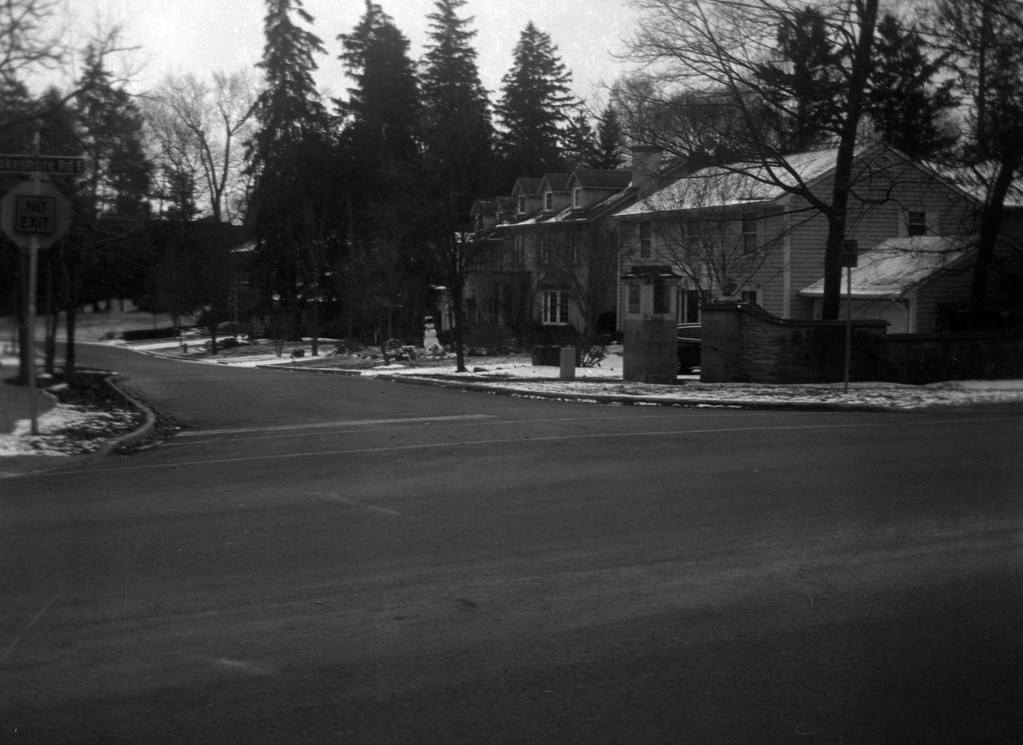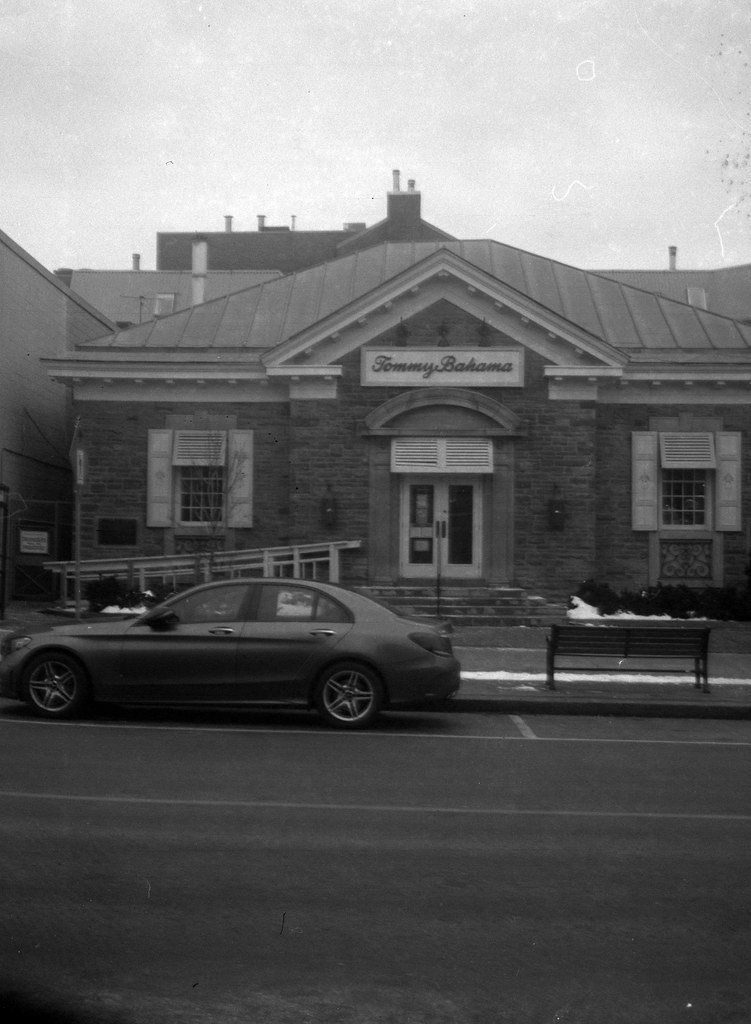I never heard of the Duex before as I scrolled past the cameras being offered up for free on the Toronto Film Shooters Facebook Group, and this camera certainly caught my eye. One of the first things to catch me attention is the design of the camera, it screams art deco and saw the production during the height of the style’s popularity. The camera itself is asking to be used amongst the amazing architecture of The Loop in Chicago, Illinois or Manhatten in New York City. But since we’re in the time of plague still, it’ll have to be more local. The Duex is one of the many 620 cheap and cheerful offerings Kodak produced in the early 1940s before the United States officially entered the Second World War. And while it’s designed for the consumer crowd, the camera itself has a rich linage originating in Germany. And while the camera itself is a far cry from the premium cameras it is originally based on; it’s no slouch in the field. A special thanks to Nancy from the TFS group for this lovely camera.
Camera Specifications
Make: Kodak
Model: Duex
Type: Viewfinder
Format: Medium Format (620), 4.5×6
Lens: Fixed, Kodak Periscopic Doublet 75mm f:11
Shutter: Rotary, 1/30″ + Bulb
Year of Manufacture: 1940-2
Background
The Kodak Duex can trace its origins back to 1930s Germany. An ominous statement for sure. Kodak by the 1930s had factories around the world and had a presence in Germany since the 19th Century as Eastman Kodak GmbH. By the 1930s the company went public, and one of their first purchases would be the Nagel Camera Werk headed up by Dr Augustus Nagel, a name that should ring a bell among many camera collectors. Using the Nagel Werks as the home of the new Kodak AG in Stuttgart and continued production starting in January 1932. While Kodak AG would become better known for the iconic Retina line in 1934, it would be in 1933 that the Kodak Duo Six-20 hit the market. A simple folder that used the Kodak 620 film format, the Duo would not indicate anything overly obvious. I’m referring to the possibility of the camera using multiple film types or two different frame sizes. Duo, in this case, indicated that the camera shot in a half-frame format. If you’re pausing at this point, don’t worry. Half-Frame usually is applied to cameras that shoot 35mm film, not medium format film. Most 620 cameras shot the 9×6 frame size, making a 4.5×6 frame size camera, in fact, a half-frame. The first series of the Duo Six-20 were viewfinder folders, equipped with a 7.5cm Kodak Anastigmat lens rated at either f/4,5 or f/3,5. The earliest models used a Compur shutter while later models used a Prontor. In 1937 Kodak AG released the Kodak Duo Six-20 Series II, the Series II marked minor changes to the camera overall mostly with improving the structural construction of the camera notably the struts that supported the bellows. It also marked the release of the camera for two different markets. The cameras produced for the American market used the same lenses as the original model cameras. But the cameras produced for the European market had three different lens options. The top tier cameras used a Carl Zeiss Tessar 7.5cm f/3,5. Then two lower-tier cameras used Schneider-Kreuznach Xenar lenses, both 7.5cm in either f/3,5 or f/4,5. Kodak made one final change to the Series II in their last production run by adding a coupled rangefinder. Still, the nationalisation of Kodak AG by the Nazi regime saw the Duo Six-20 end production in 1939 at the start of World War Two. Making the rangefinder equipped Duo’s rare on the market today. The 1940s brought a shift in Kodak’s 620 cameras, no longer would they be metal quality products, rather they would be aimed at the consumer and entry-level market. In 1940, the Duo’s successor the Duex saw released. The only thing shared by the cameras was the use of 620 films and the 4.5×6 frame size. The mental body became bakelite, and the bellowed a screw out helicoid. The lovely glass became a simple doublet lens rated at f/11. Kodak also shifted production of the Duex to their Rochester and Toronto plants. The camera lasted only two years; the reason for the end of production is unknown. But by 1942 the United States had entered World War Two, and war production had ramped up among all Allied nations. Or the camera got lost among the tonnes of similar cameras on the market by both Kodak and other camera producers making the Duex little more than a footnote in Kodak’s catalogue of the mid-century.


Impressions
If you’re a fan of the art deco style, then this camera will match that aesthetic in a clean fashion. Sure it doesn’t have those iconic art deco faceplates that Kodak is known for (Think the OG Jiffy Kodak), but you can clearly see that art deco style upon seeing the camera and more importantly the box. Now the camera itself is simple and doesn’t have too much in the way of decoration, but the rounded edges at the front of the body, the big lens barrel for such a small optics. That is one thing you will notice about the camera is how in several cases the controls are overly large, the shutter release, speed selection (you only have two), and the film advance. Makes it easy to use with gloves, which I was during the time I shot the camera for this review. The plastic construction, bakelite to be exact, gives you a lightweight camera and a classic fabric cord for a strap. In fact, when I was out working with the camera, I could barely feel the weight of it around my neck. Overall the Duex is an excellent looking camera and a good addition to anyone’s collection of mid-century Kodak cameras.

Experiences
Before I dig into my experience with the Duex, much of the things I’m going to say about the camera I’m going to chalk up to age and the modern spools being used in the shooting of the camera and I’m sure it was for the day an average camera of its type. Loading the film takes a bit of effort, mainly with opening up the camera back. Thankfully having some experience with full back removal for loading film. Thankfully my copy of the camera came with an empty 620 spool an OG metal spool! Thankfully these days, the Film Photography Project not only produces new plastic 620 spools they also spool 120 films onto these spools to allow me to use the Duex easily. Or so I initially thought. The spools are held in place by metal holders that have some bend in them to get your film spools in and out of their places. The advance proved stiff and took a fair amount of effort even to get the film moving, and that seemed to be the trend throughout the whole roll. Thankfully the black backing paper and white text provided good contrast so that I didn’t miss a frame when advancing. The viewfinder is small and is rather dirty and almost useless for composing the images. I ended up shooting more from the hip than using the horrid viewfinder. At least it gave me an idea of how the frames would look. And here we have my biggest beef with any cameras of this type, remember my big complaint about the FPP Debonair is that the frames are composed in 4.5×6, not 6×4.5 my preferred way of composing the negative size. The biggest thing throughout shooting the camera is the concern that something didn’t catch right, the stiff advance did have some problems and results in a buckled film plane, and several straight lines were far from straight. Ultimately the advance seized up so much I could not complete the full advance to the end. Thankfully I got the film taken out in a dark bag and developed successfully. Other than the advance, the camera is easily used with gloves thanks to having a large shutter release. But don’t expect too much control, there’s no adjustment for focus or aperture. One shutter speed or bulb that’s it, and I think my shutter is slower than the 1/30″ and that worked in my favour shooting f/11 on ASA-100 film in dull light.

Optics
Although everything I don’t like about the Duex, where the camera shines is the lens, this isn’t my first time working with a Periscopic Doublet; the Jiffy Kodak II uses the same optics, a simple two-element glass lens. Rated at 75mm and a fixed aperture at f/11 you’d expect a little more from the glass. The 75mm is pretty standard for a 6×4.5 camera giving a ‘normal’ field of view and f/11 offers up a decent depth of field. But the two-element design offers up a lot of character, the centre of the image is sharp with a lot of fall off as you get to the corners, which is surprising with an f/11 aperture. It actually reminds me of shooting a Holga with the 6×4.5 mask instead of the 6×6 standard. Overall the results are overly soft; I say that because I think the camera can produce sharper images, but two things are holding it back. The first being that the film did not load properly nor did it advance properly, which I believe has something to do with the small differences between the plastic and metal 620 spools, but no big deal. The second being age and grim, thankfully the second one is easily cleaned up, and I may take some time to clean up some of my older camera lenses.

Lowdown
If the one thing holding you back from trying out a Duex is that 620 film is hard to come by, don’t, the Film Photography Project sells both new spools and spools 620 film that’s fresh, and you might even find some OG 620 film that is well stored available for sale. And you can always re-spool 120 film onto recovered or salvaged 620 spools yourself. A camera like the Brownie Hawkeye Flash is an excellent way to do this, as it can take a 120 roll, remember after spooling it one way, spool back to the original start, so all the numbers are right. Thankfully the camera has next to no value on the used market and often you can find them for next to, if not nothing at all. While not a camera I would use regularly, given the age of the camera it makes for an excellent shelf queen or addition to a World War Two American encampment at a timeline event. I do plan on adding the camera to my shelf and giving it some TLC to clean it up and make it look pretty. Plus being a copy made here in Canada at the former Toronto Kodak plant that I explored one of the surviving buildings many years back, I have a touch of attachment to the bakelite beast.

Further Reading
Don’t just take my word on the Duex, you can check out the reviews by other awesome camera reviewers!
Vintage Camera Lab – Kodak Duex
Matt’s Classic Cameras – Kodak Duex
Random Photo Blog – Kodak Duex
Junk Store Cameras – Kodak Duex

